"It might have sunk without a ripple but Harry Saltzman
had just made the first Bond film (Dr. No, 1963) and it did
very well, but that was really because the critics used me
as a blunt instrument to beat Ian Fleming over the head." |
Novelist, Len Deighton |
Even as a child, I knew James Bond and the whole 007 milieu was (in the original sense of the word) a fantastic fiction, a delicious blend of cinematic promise, expectation and pay off. You could argue that there is some relationship to the real world if you confined yourself to the first two in the series but once the ejector seat fired a risibly silly dummy into the air at Auric Goldfinger's factory, we all knew we were in a wonderfully comfortable and utterly unreal universe where Bond was a fantasy superman and the movies whirled around the lead actor glorifying his every move. The word I am looking for here is 'fun'. The only moment in the franchise when Connery was in serious trouble was during the encounter with Red Grant in From Russia With Love, still for my money the best screen fight in a mainstream film. I went back to the books and was shocked and not a little disappointed that few of Fleming's stories had anything in common with their subsequent movies. The literary Bond had very little to do with the cinematic Bond save perhaps their titles. The 007 formula was a supremely successful one and until Bond film editor Peter Hunt tried his directorial hand with a few surprising and perverse wanderings off the path with On Her Majesty's Secret Service, we all knew what we were getting. Peter Hunt also edited what must have been seen at the time as 'the real deal', a movie that illustrated what the life of a secret agent might really have been like.

The Ipcress File is the remarkably assured work of a young director and an editor whose narrative skill extended to not even needing the director to guide him in the cutting room. Director Sidney J. Furie, a high-flying Canadian, did not wholly get on with deal-maker extraordinaire, Harry Salzman, co-producer of the ongoing Bond franchise. It's almost unheard of these days that a director could be locked out of his own cutting room but as director and editor are both reunited for the commentary, there doesn't seem to be any bad blood – far from it. More on that commentary later. The comparisons with Bond at that time were inevitable. 007 stalwart Harry Salzman made sure there were many Bond regulars behind the camera, the most conspicuous being composer John Barry, designer Ken Adam and afore mentioned editor, Peter Hunt. This was London in the sixties, a boom time for hipsters (as they weren't known then) and a secret agent love affair that to a degree is still ongoing, Bourne again, you might say. I was alive throughout the period but alas barely out of the toddler phase unable to appreciate what was a cultural explosion of a sort. Author Len Deighton's independent, Burnley-born, working class hero (unnamed in the novel) is played by Michael Caine and is one of the defining roles of his career. His cinematic name, Harry Palmer, was taken from one of the boys Caine was at school with. Caine wanted a very dull name for his spy, the thinking behind the choice of 'Jones' for Indiana (née Henry). As for the use of 'Harry', take a look at the older Michael Caine interview in the Extras.
Deighton's deliberately drab environment crosses over with fellow scribe John Le Carré's though it's fair to say that in The Ipcress File, there are no smiley people. This is secret-agenting at its most mundane, its very basic level; government employers pass manpower between them and the smell of tobacco and damp edging out from ancient buildings' faded interiors reeks to high heaven. It is a place where the word 'espionage' has real world significance. The opening scene, echoed by Harper starring Paul Newman a year later, is simply Caine getting up and preparing coffee. While the no doubt hip grinder does its thing, we get the title. This is mundanity as a slap in the face to big budget fare. This is kitchen sink drama for the spy game. Caine's ex-Army sergeant with a dodgy past has been transferred to another department to try and halt the brain drain from the UK. Very bright men (and women presumably) are being kidnapped undermining Her Majesty's government's attempts to keep control on what little of the globe it still thinks it owns. Two department heads swap Caine's services and it's unclear from whom Caine is taking orders. In a way it's not that unclear. Caine takes orders from Caine. His insubordination and instinct make him a good field operative although there are very few what we now call 'action scenes'. There's a brief fight on the London streets (specifically asked for by the studio still under the delusion that hit movies contained elements that were to be simply aped). Cinematic success is a magic spell, not a marshalled collection of 'things that seem to have worked in the past' and I'll stand by that despite the millions of dollars that seem to prove me wrong. After all, it was Jean-Luc Godard who said that... "All you need to make a movie is a girl and a gun..." Most of the film is Caine inching closer to his target by reliable plod work. This is a world without computers and information must be dug out by hand and obtained from personal connections. There are deaths and double crossings along the way but the pleasure of the film (oddly) comes from its concrete placement in the absolute ordinary and the extraordinary way in which director Sydney J. Furie has captured it.
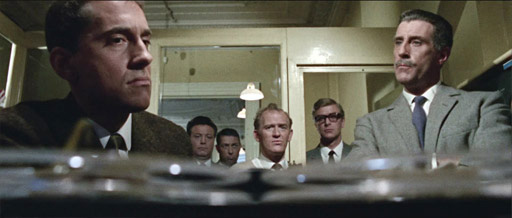
Furie has a cool, detached style and sometimes directs his camera operator towards diagonal comic book framings that work curiously well. Dutch tilts as they are known combined with many odd but curiously dynamic framings gave Ipcress a real visual identity, a breath of fresh air after what was expected of a director in 1965. Furie deliberately framed the action from behind all sorts of objects, obscuring the frame with shoulders, lampshades and reel-to-reel tape recorders. Some of the most striking compositions are taken from almost carpet level. We see this style and accept it in 2014 – this is a director with a flair for the unusual but effective composition. In the early 60s, this 'style' looked like a series of deliberate mistakes, so unused were audiences (and studios) to this theatricality. I think it earmarks this cool and aloof movie as something rather special. I have a short confession. I wasn't half as impressed with Ipcress until I really studied it by watching it with the commentary on. By the constant presence of context in my thinking, I came away from my third viewing with a profound admiration for Furie's work and I'm no longer surprised at how many well known individuals cite Ipcress as a benchmark movie.
The Bond alumni acquit themselves with aplomb. In the main theme orchestration, John Barry foregrounds the Hungarian instrument called a cimbalom (it looks like a small exposed piano with strings you strike with pad-ended sticks). This specific sound nails itself to the movie as much as the zither's jolly strumming did to The Third Man. Ken Adam, no doubt with a smaller budget, chose to minimalise the existing locations and strip them of furnishings while his Pinewood work is just as sparse but distinctive. But the technician who seems to have been at the heart of the endeavour was Peter Hunt, the editor so obviously trusted by producer Salzman whereas director Furie was not. I worked on a film a while ago that had drama inserts inside a quirky documentary framework. I was sent the drama rushes and without the director, I cut them according to how the shots and performances spoke to me and was utterly delighted to have confounded the director who said to me "How did you know this cut was exactly what I had in mind when I directed the shots?" I said "Because the rushes told me..." I don't think a frame was altered all the way down to the end of the edit. I was as delighted to find out that editor Hunt did exactly the same with Ipcress as all throughout the commentary Furie keeps being amazed that Hunt knew what to do with his rushes. Bless.
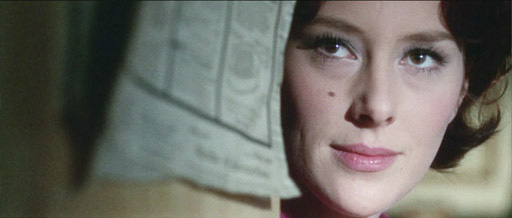
So the main pleasure to be gained from this movie (apart from the narrative which is suitably taut and gritty) is the stylistic way in which it was shot and directed and taken in context, it's something quite startling. The acting is solid with stand out praise going to the lugubrious Nigel Green as Major Dalby and the quiet, confident authority from a soon to be No. 2 in The Prisoner, Guy Doleman as Colonel Ross. Then there's the all too necessary 'dolly bird' (not my phrase, believe me. Listen to the commentary...) to give the hero's attractiveness a softer validation. This is a nod to bed-hopping super spies, more in line with Bondian ethics than the world of Harry Palmer although to be fair, we meet Harry in the opening scene expecting there to be a woman in bed with him. Why on Earth he finds his gun in the middle of his bed brings up a number of questions I'm not prepared to ask. The 60s-specific beauty, Sue Lloyd, plays Jean, an operative sent to watch over Palmer. I mean no disrespect. I'm sure her beauty traversed the decades. It did. I watched the soap opera Crossroads! What I meant was that her look at the time was very rooted to the time and place in which it flowered, very Jean Shrimpton. In the novel Jean (coincidence? Perhaps not) is a small part of an entourage sent out to a Pacific island to test a neutron bomb (I imagine the budget scuppered this part of the story) and her role is significantly enlarged for the movie – no surprises there. If the biggest thrill of the movie itself is its direction, by far the biggest pleasure of this particular Blu-ray is the commentary and it's one of many Extras. Soon... Soon.
Shot in Techniscope® aping the 2.35:1 anamorphic process (a two perforation 35mm format which essentially halves the stock budget and allows the use of any lens, not only anamorphic ones), The Ipcress File looks suitably dark and muted in the murkier colour range. It shows some grain consistent with its source material. While the print is relatively clean and free from damage and dust spots, the sharpness is not as defined as most modern movies. For a start, it was originated on half the surface area of normal 35mm and I imagine the celluloid material from which the disc was originated was some sort of interpositive (another generation loss). This does not detract at all from enjoying the film as presented.

You have the choice of the original mono and (as far as I could tell) a simply made remix for Dolby 5.1 Surround. The sub and surrounds don't really come into play. The dialogue and occasional gunfire are both rendered perfectly well and there's never a problem with clarity. There are additional English subtitles.
All are Standard Definition (unless otherwise stated)
Michael Caine is Harry Palmer – interview with Sir Michael Caine (19' 11")
Shot in 2006 presumably for one of the movie's Network DVD releases, Caine gives a good background on his relationship with Harry Salzman and how he came to play Harry Palmer. There is a preponderance of clips from the main feature, a practice that wears out its welcome quite quickly. There's a wonderful testament to the natural talent of cinematographer Otto Heller who used a light meter on set. When he died, it was revealed that the light meter had been broken for years and because he'd seen other DoP's use them, he felt he needed to act out the charade of using one too. The fact that he didn't need one prises out a serious amount of respect from me. Caine also reveals that Peter Hunt (there's that man again) allowed director Lewis Gilbert a sneak peak of Ipcress that lead to him signing Caine as Alfie. I particularly responded to Caine's point about the importance of music in movies. He attended a music-less screening of Dr. No and apparently both producers Broccoli and Salzman were suicidal. How things changed once that theme was added...
The Design File – interview with production designer Sir Ken Adam (10' 31")
The always reliable (anecdote-wise) Ken Adam, whose production design has blessed an entire era of filmmaking, talks about his contribution to Ipcress. He reinforces the idea that a happy set will yield great results, citing that with one exception (presumably Harry Salzman and Sidney J. Furie), everyone clicked. Nominated for a BAFTA twice in the same year for both Goldfinger and Ipcress, Bond producer Cubby Broccoli refused to speak to Adam after he won for Ipcress. This is Adam's account in the interview. Just for the record, it was Thunderball, not Goldfinger that Ipcress was up against.

Michael Caine Goes Stella comedy short (5' 02")
Phil Cornwell does his Michael Caine schtick at the behest of Network for the 2006 DVD release doing various sketches on an Ipcress theme. Diverting but not exactly must-see material.
1969 documentary: Candid Caine (44' 10")
This is very dated (duh) which may account for its slightly off-centre oddness. Its title is a play on the title of a famous TV show at the time, Candid Camera (a comedic half hour which set the public up so that they react realistically to set up situations). It's a show I actually remember watching as a young boy. Candid Caine is funny too but not intentionally. Here is Michael Caine in the prime of his life and at the height of his career doing an 'exposé' of himself, a 'self-portrait'. He visits his early neighbourhood and generally lets the poorer half see how "a poor man done good" lives. He talks about wanting to maintain the lifestyle that money had granted him and it's all a little off key. This attitude also manages to explain his vast body of work, a greater percentage of which is pretty unremarkable. He's far too self-conscious a man (he's not acting here you see) to make the viewer feel entirely comfortable. There's even a badly misjudged scene when he's reacting to fan mail that has creepiness stamped through it, like rock. The nicest moment is an elderly neighbour who of course addresses him by his real name, Maurice (Caine was born Maurice Micklewhite). The status his wealth affords him seems to be the constant theme running through this 'self portrait' and there's something slightly creepy about a man walking through an old neighbourhood being recognised as the great Michael Caine while his fecking Rolls Royce follows him at a discrete distance just in case he has to pop back into Richland to reassure himself.
Original theatrical trailer (HD – 1' 04")
"His name is Michael Caine. And no one will forget His Name!" With almost every frame of action in the film included in the first seconds of the trailer, (curiously though not a frame of the fight in the street), this example of the breed is typical of its day. "The Spy Thriller That's Hot!" It shamelessly dangles a Bond-type hook (girls and guns) and doesn't give anything away about the real nature of the film it's promoting. Unless there's a cue in the film I missed with the cimbalom going twice the speed, the John Barry piece that starts the trailer off with a bang has been speeded up (to match the action?). It's almost comic to those so familiar with the music. Not sure this was HD either but benefit of the doubt and all that.
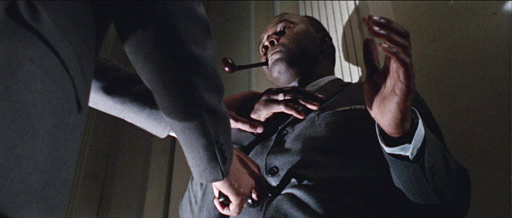
Textless material (HD)
Film delivery requirements to foreign markets necessitate the generation of textless shots upon which can be optically printed the different language titles and credits. They have no entertainment value whatsoever and I find their inclusion on this Blu-ray odd to say the least. The more Extras, the more attractive the package?
US Radio Commercials
Uh... OK. Mostly low voiced quotes from American journals that begin with the whispered lines "Spy men, spy men, what do you see? One murder, two murder and mine makes three." Uh... OK. Not sure if Palmer is a double agent (pretty sure he's not), "...a thinking man's Goldfinger, funnier by far than the Bond thrillers." Drier perhaps but Ipcress is not exactly Blazing Saddles. This is an historic curio, nothing more.
Extensive image galleries
There are four in all...
Production Images – There are 46, the first few a little garish, far from the muted colour scheme of the movie itself. This collection also features frame blow ups from the Techniscope® frame.
Behind the Scenes – As it says but remarkably few of Sidney J. Furie.
Portrait – 23 specially shot portraits of the cast.
Promotional – Loads of posters from world markets (all lying through their collective teeth; "The most 'sexpionage' story you will ever see!" You think?) and assorted front of house stills.
Commemorative Booklet
This was not available for review.
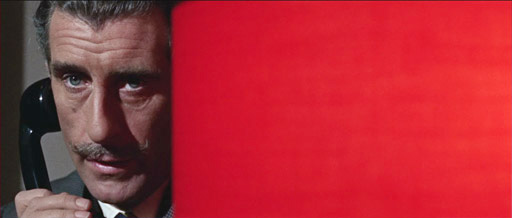
Commentary with director Sidney Furie and film editor Peter Hunt
I've saved the best until last... If the movie is the sleek feline of cautiously realistic spy shenanigans, then the commentary is the cat's pajamas. Recorded for the 1999 release on DVD and Laserdisc (in widescreen, heaven), this is exactly what all commentaries should be.
Here are two professionals reunited to share their memories of a significant time in their lives and obviously both have such high regard for each other, the commentary steers perilously close to a mutual love in but that aside, this is the best commentary I've heard in a long time. I have to also admit that I heard it slightly speeded up (I have a day job, remember?) You can still make out the words clearly going slightly faster and in this condition, Furie sounds exactly like Martin Scorsese.
Given this particular commentary is fifteen years old, maybe I should have caught up with it sooner but what these two men say about filmmaking then and now is priceless despite being over a decade out of date. I am so tempted to outline all the points that so appealed to me but that would add another few pages and besides, the commentary is there to surprise you and this one's a cracker. That said, I'll pick five favourites from my extensive list, two of them alcohol based.
One: Obviously under some pressure from a producer that didn't rate him (both men were stubborn but Salzman had the clout), Furie used to put a nip of scotch in his coffee, Dutch courage indeed. Peter Hunt reminded him that this wasn't something to own up to.
Two: Furie was astonished that the English crew broke for lunch and drank alcohol at pubs. In the US, you'd be known as an alcoholic and a drunk if you drank anything during the day. This puts the British film industry in another perspective.
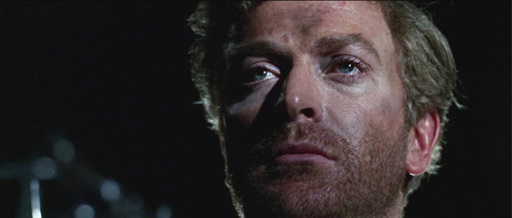
Three: Furie once went to introduce himself to a hero of his, cinematographer Vittorio Storaro on the set of Coppola's One From The Heart. The esteemed cinematographer turned to him and said "You don't have to tell me who you are... I've stolen from you!" Storaro told him that Ipcress had a huge effect on young Italian cinematographers starting their careers in the 60s.
Four: It seems that Furie's creative juices flow on the actual shoot. He admits to never pre-planning and making it all up when he's on the set. Somehow I can't imagine the words Sidney J. Furie and green screen in the same sentence. I know exactly what he means. The physical space can inspire you in ways that green screen and unlimited and potential digital creation cannot.
Five: Not only was director Furie (Agents Of S.H.I.E.L.D. fans nod at the coincidence) banned from his own movie's party at the Cannes Film Festival, but also producer Salzman accepted the BAFTA for Best British Film on Furie's behalf when traditionally the award in those days went to the director. Salzman kept it, effectively stealing it from the man who deserved it. Nice.
The Ipcress File is a movie that sneaks up on you. I admit that when I first saw it I was impressed but not half as impressed as I am now after delving a little deeper. Furie's career didn't really take off after Ipcress although the talent was obviously there. But if you're after a solid and at the time visually groundbreaking spy movie produced in the middle of and despite Bondmania, then Ipcress is for you. Well recommended.
|